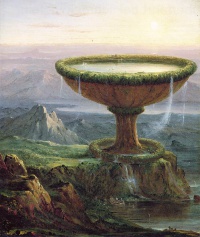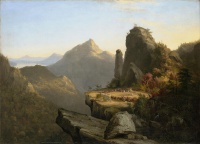Thomas Cole
From The Art and Popular Culture Encyclopedia


|
Related e |
|
Featured: |
Thomas Cole (1801 - 1848) was an American artist regarded as the founder of the Hudson River School, an American art movement that flourished in the mid-19th century and was concerned with the realistic and detailed portrayal of nature.
Contents |
Early life and education
He was born in Bolton, Lancashire. In 1818 his family emigrated to the United States, settling in Steubenville, Ohio, where Cole learned the rudiments of his profession from a wandering portrait painter named Stein. However, he had little success painting portraits, and his interest shifted to landscape. Moving to Pittsburgh in 1823 and then to Philadelphia in 1824, where he drew from casts at the Pennsylvania Academy of the Fine Arts, he rejoined his parents and sister in New York City early in 1825.
Painting
In New York he sold three paintings to George W. Bruen, who financed a summer trip to the Hudson Valley where he visited the Catskill Mountain House and painted the ruins of Fort Putnam[1]. Returning to New York he displayed three landscapes in the window of a bookstore, where as recounted in the pages of the New York Evening Post [2] they attracted the attention of the painter John Trumbull, who sought him out, bought one of his canvases, and put him into contact with a number of his aristocratic friends including Robert Gilmor of Baltimore and Daniel Wadsworth of Hartford, who became important patrons of the artist.
Cole was primarily a painter of landscapes, but he also painted allegorical works. The most famous of these are the five-part series, The Course of Empire, now in the collection of the New York Historical Society and the four-part "Voyage of Life." There are two versions of the latter, one at the National Gallery in Washington, D.C., the other at the Munson-Williams-Proctor Arts Institute in Utica, New York.
Cole influenced his artistic peers, especially Asher B. Durand and Frederic Edwin Church, who studied with Cole from 1844 to 1846. Cole spent the years 1829 to 1832 and 1841-1842 abroad, mainly in England and Italy; in Florence lived with the sculptor Horatio Greenough. After 1827 he had a studio in Catskill, New York. In 1836 he married Maria Bartow of Catskill and became a year-round resident. He died at Catskill on 11 February, 1848.
Architecture work
Cole dabbled in architecture, a not uncommon practice at the time when the profession was not so codified. Cole was an entrant in the design competition held in 1838 to create a new state government building in Columbus, Ohio. His entry won third premium, and many contend that the finished building, a composite of the first, second and third place entries, bears a great similarity to Cole's entry.
See also

